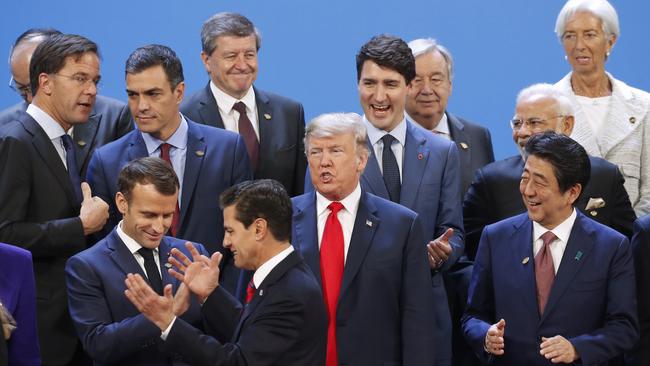China-US trade deal a relief for markets
The trade truce struck between Donald Trump and China’s Xi Jinping at the weekend will be a relief for world markets.

The trade truce struck between US President Donald Trump and China’s Xi Jinping at the weekend will be a relief for world markets this week given months of escalating trade tensions between the two countries.
But while photos of Saturday night’s formal dinner in Buenos Aires on the sides of the G20 between senior US and Chinese officials and shots of the two smiling leaders shaking hands are a much-needed sign that the leaders of the world’s largest economies are back on talking terms, there is now a 90-day clock ticking for China and the US to reach a deal.
The deal — or, to be more accurate, loose agreement reached at the weekend — could also have negative effects on Australia if China comes under pressure to buy more agricultural products and LNG from the US — two areas where Australia competes directly with the US in the China market.
Under the deal struck over dinner in the Argentina capital, Trump has agreed to hold off raising the tariff rate on $US200 billion ($274bn) of Chinese imports to allow for additional negotiations to strike a deal.
If there is no deal at the end of the 90 days, the US will go ahead with its plans to increase the tariffs on $US200bn of China imports from 10 per cent to 25 per cent, which was supposed to begin on January 1.
China has agreed to buy a “very substantial” amount of goods from the US to reduce the trade imbalance between the two countries in the areas of agriculture, energy and industrial goods, while the US has said it also wants to press China over concerns over its trade practices.
In a show of goodwill, Xi also indicated he would reconsider his attitude to the proposed merger between US semiconductor company Qualcomm and Dutch company NXP Semiconductors — a deal that fell apart after Beijing opposed it earlier this year.
Whether both sides can reach a suitable deal that will be acceptable to a sometimes erratic Trump administration remains to be seen, although a trade truce is a lot better than the atmosphere of escalating tariffs and uncertainty that was in place until the meeting.
As China now looks to step up its purchases of goods from the US, there could well be unexpected fallout for countries such as Australia as China, Australia’s largest trading partner, will now be scrambling to find areas where it can buy more goods from the US.
Earlier this year China announced higher tariffs on some US imports including wine, beef and LNG as part of its retaliation moves against Trump’s tariff on Chinese imports.
But if China now suddenly has to open its cheque book and agree to buy more American goods, Australian suppliers could be hit as Beijing orders its buyers to redirect their purchases from Australia and other countries to the US.
Uncertainty around the weekend deal, which is basically an agreement to start negotiations, will remain for months until it becomes clearer how far China can go in meeting America’s demands and whether Trump is serious about reaching a long-term resolution of America’s trade concerns with China or whether he is just providing both sides — and other players in the global economy — a much-needed break in tensions.
The International Monetary Fund has been warning for some months of the potential damage to world economic growth from escalating trade tensions between the two countries.
There was no joint statement from the weekend meeting, with both sides releasing their own version of what had been agreed.
While the Chinese side went first with the news that a deal had been struck, statements later from the White House indicated that the ceasefire was highly conditional.
“President Trump and President Xi have agreed to immediately begin negotiations on structural changes with respect to forced technology transfer, intellectual property protection, non-tariff barriers, cyber intrusions and cyber theft, services and agriculture,” the White House said in a statement.
“Both parties agree that they will endeavour to have this transaction completed within the next 90 days.
“If, at the end of this period of time, the parties are unable to reach an agreement, the 10 per cent tariffs will be raised to 25 per cent.”
The statement said that as part of the agreement, China has agreed to purchase a “very substantial amount of agricultural, energy, industrial and other product from the US to reduce the trade imbalance between our two countries”. It added that China had “agreed to start purchasing agricultural products from our farmers immediately”.
No figures were mentioned on how much extra goods from the US that China would be expected to buy.
Chinese Foreign Minister Wang Yi, who met recently with Australia’s Foreign Minister, Marise Payne, in Beijing recently, said China would only be buying more goods from the US “according to its domestic market and people’s demands”.
He said China would gradually solve the “legitimate concerns” of the US side but did not provide any more detail on how this would be done.
Under the agreement, both sides have agreed to stop imposing any additional tariffs — at least for the next 90 days — and to step up negotiations to eliminate the extra tariffs that have been imposed this year as part of the trade war.
Equally as important have been the atmospherics around the meeting, which both sides have hailed as being positive, and are a long way forward from the dark days no so long ago when US Vice-President Mike Pence delivered a major verbal attack on China.
Wang Yi said Trump and Xi had “friendly and candid” talks over dinner, during which they reached an “important consensus” that could help improve the bilateral relationship.
Just having a cordial meeting between Trump and Xi on the sidelines of the G20 was important in itself, but the real practical outcome of the deal is yet to be seen.
It is unlikely that China will be able to make some of the major concessions that Trump would want on areas such as intellectual property protection, technology transfer and non-tariff barriers, but it very definitely will mean more Chinese purchases of US goods.
Just what other countries’ exports to China might be affected by this is something that Australia needs to watch carefully.
In the short term, Trump’s hardline America First policies are now the name of the game, as China makes concessions while Trump holds the whip hand in the form of higher tariffs on Chinese goods that could still come into force in March.




To join the conversation, please log in. Don't have an account? Register
Join the conversation, you are commenting as Logout